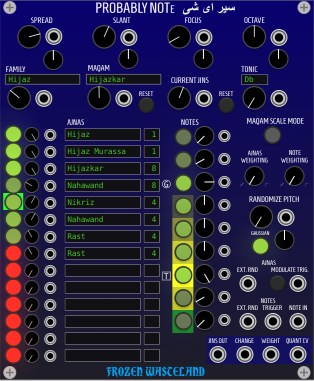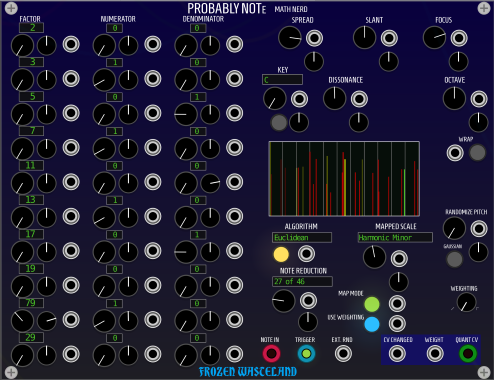Discovering tuning outside standard piano tuning can feel like finding food with seasoning and spices for the first time. Here are some new resources – strong enough for tuning experts, easy enough for beginners (well, some of them).
If you just want to skip ahead, I cover some tools you can use now at bottom. But if you’re curious —
Your tuning isn’t “standard”
Many of these tools refer to “microtonality,” but historically speaking, that’s a weird term. Saying “microtone” usually suggests a division of the semitone – so it means some subdivision of your existing scalar tones. The question is what the starting point is.
Music software though tends to talk about “microtonality” in regards to all tunings that aren’t 12-tone equal temperament [12-TET]. (That’s the dominant system for tuning pianos and other instruments in recent centuries in the west. If you’re unsure, turn on FM pop radio – it’s there.)
Microtonality does have historical basis. That is, dividing scales into smaller scales is definitely a thing – though Persian and Arabic music got there long before any of the 20th-century composers now associated with it. Safi al-Din al-Urmawi was on this s*** back in the 13th century. He comes from… actually, let’s not get into border politics of modern Iran and Azerbaijan, especially after just talking about the West Bank of Palestine. Let’s just crank up the volume and party Abbasid Era style!
Music students will often get introduced to ideas like “quarter tones” with names like Harry Partch (USA) and Conlon Nancarrow (USA/Mexico). Where they picked it up is itself interesting – Partch may have been influenced by indigenous Native American music in his childhood home of rural Arizona. (See Not Even Harry Partch Can Be An Island.) Partch is a nice model for CDM readers in that he also built his own instruments to break free creatively.
The problem with “microtonal” is, there’s the implication that 12-TET is a “standard.” But 12-TET represents a relative subset even of the timeline of “western” European music. (Anyone bothered by “western” – here it literally refers to the split in the church. Western music has its origins in the western church – the church in Rome, rather than all that Orthodox Christian jazz in the east.)
12-TET’s dominance in electronic music speaks to the 20th-century power of the United States and Europe and the legacy of colonialism … and with it, the primacy (for a while) of pop music. Colonialism brought western music theory and this tuning system came along for the ride. Then mass media got it in everyone’s head with those catchy, catchy earworms – though the fact that pop music lately is stuck on the same four chords suggests it may be running out of steam. That’s nothing against 12-TET itself – it has some mathematical appeal. But 12-TET has nothing to do with most music produced in the world before the 20th century. Even Bach almost certainly didn’t use equal temperament. (The answer to what tunings he did use is complicated, but if you go hear some good baroque musicians playing period instruments, you’ll probably get some nuance.)
So what we really have is different tunings, and they’re as varied as the spices in food. Persia (modern Iran), China, India, and Indonesia all have dominant tuning systems (and their own history of political and economic power spreading those systems). African music has its own systems – there’s actually a great Brittanica article on the topic as an overview. (Think 5- and 7-tone scales and then… lots of complexity from there.) Arabic maqams are, of course, legendary but also closely related to that “western” music thing – the “eastern” music (the eastern church) uses related tunings, as did early Jewish music. And the list goes on…
In other words, just like the English language, having a scale that’s divided into 12 equal steps (equi-dodecatonic) is really an outlier, historically.
Why this matters to electronic music, uniquely, is that you can produce entirely new instruments. It allows you to produce music almost as an alien being, if you choose – or because the computer is a blank slate, you can “decolonize” your machine’s tuning. Even MIDI doesn’t really embody a particular notion of tuning so much as it uses the number of available bits in its data structure.
This is all useful creatively because, as you may have noticed, eventually you get bored of notes and can’t come up with ideas. So maybe it’s not you – maybe it’s the tuning. It’s like eating nothing but breakfast cereal every day. (Ironically, a common trope for why there can’t be new music is “there are only so many notes.” Answer – no, really, mathematically speaking, there are literally an infinite number. So there.)
But why do it? Because it’s fun. Because you can better express yourself sometimes in tones between those imposed pitches – as you do already with language.
I’d argue a lot of music has already broken away from the hegemony. From hip hop to techno, you hear all kinds of bi-tonality and pitch relationships that would be dissonant in modern music. It may be technology that ultimately determines what happens.
And it’s significant that given something like a modular synthesizer, you naturally start to play with stuff outside the normal scale. It suggests that maybe your ear/mind are ready for some new relationships. Our ears are certainly very sensitive to tuning, likely because without that sensitivity we wouldn’t be able to spatialize sound and would … regularly injure ourselves. (“Tone deafness” is in my experience more related to the difficulty of reproducing pitches, which is why people are sensitive about their singing.)
So let’s get into some of this, as there are some developments even in the last weeks.
Bitwig Studio Micro-pitch tutorial
First – Bitwig Studio. Micro-pitch is one of the friendliest additions to music software for managing tunings. You can drop it in, hit a preset, and go. And, bonus, Bitwig has some of the most robust support for MPE (MIDI Polyphonic Expression), meaning you can transform your computer into a rich instrument with per-note expression and custom tunings.
Bitwig just published a new tutorial and accompanying video explaining how to go deeper.
And there’s a great guide:
Community › Learning › Microtuning in Bitwig Studio
VCV Rack
Modular software platform VCV Rack has its own, official, paid module called Scalar. And it’s great – and probably the easiest way to map voltages to different tunings in Rack. But if you want to go deeper, there’s Frozen Wasteland.
And there’s been some action from Frozen Wasteland in updates, even from the last days. I am a little wary to recommend them as there are some bugs, and they’re not the most user-friendly things. But there’s some real power and potential here, if you want to dive in and help us figure them out.
The modules all derive from an original quantizer called Probably Not(e). (har) It’s a probabilistic quantizer – that is, add some input voltage (or MIDI input or a sequence or whatever), and it will scale the output to a particular tuning. That first module already is mobbed with features, but there are variants. There’s one devoted to the 13-note Bohlen Pierce scale.

There’s an Arabic module – which needs its own dedicated support, really, because Arabic jins and maqams are melodic modes, not just tuning systems. The direction of your melody will determine the tuning. (A good violinist, for instance, does this even in western music in a subtler way – slightly adjusting the intonation up or down depending on position in melody and harmony.)
And then there’s the massively expanded MATH NERD edition of the module:

Group post on that:
https://www.facebook.com/groups/vcvrack/permalink/592625634730918/
But it is simply bonkers:
- Up to 10 Prime numbers can be used as either numerators or denominators to create pitch ratios
- If the value in numerator or denominator is > 0, that factor is used (0s are ignored).
- If a value > 1, then powers of the factor up to that value are used (ie if factor is 5 and numerator/denominator value is 3, then combinations 5, 25 and 125 are used)
- Example: If 2 and 3 are used for numerators and 5 and 7 are used for denominators, pitch ratios generated are 2/5,2/7,2/35,3/5,3/7,3/35,6/5,6/7 and 6/35.
- This can potentially generate a LOT of pitch ratios
Uh… yes. Actually even though I said microtonality implies some norm that you’re subdividing, this does really qualify as microtonality. Whoa.
Learn Arabic music – and liberate yourself from scale tyranny!
Just to take one intonation and modal system, though, it’s worth pointing to the music text that Frozen Wasteland used to inspire the Arabic module. (Much to surprise, I went to grad school with the author of that very text, an Arabic violinist/vocalist/musician in NYC with expertise in Egyptian and Syrian traditional music.)
Learning Maqam requires some effort – this isn’t just a tuning, but a whole way of thinking about pitch and melody in time. Sami Abu Shumays has built a friendly site to explore, with musical examples:
Sami and Johnny Farraj have a book on this, too, if you are looking for some summer reading music nerd style. And for just one mind-bending idea, open your brain to the arbitrariness of the scale:
Here’s one tidbit, especially for all of you involved in the production of music software: “The point is, determination of scales is cultural: No rigid mathematical law of music theory says that a note has to be in a specific position,” he says. More on that book and reading:
Authors Johnny Farraj and Sami Abu Shumays go deep ‘Inside Arabic Music’ [Centerline]
There may be other references people suggest, but it is useful in being a reasonably deep guide that nonetheless gives us newcomers a place to start.
To take a 20th century standard example of what he’s talking about, there’s Umm Kulthum. I mean, it’s an obvious choice to represent Egyptian music of the last century, but it sure makes me weep:
I can’t embed it, but go listen. And dear CDM readers, this was long, but – as Umm Kulthum would say, you are my life. Enjoy!
Now I am really curious to learn more about tuning in Uganda…